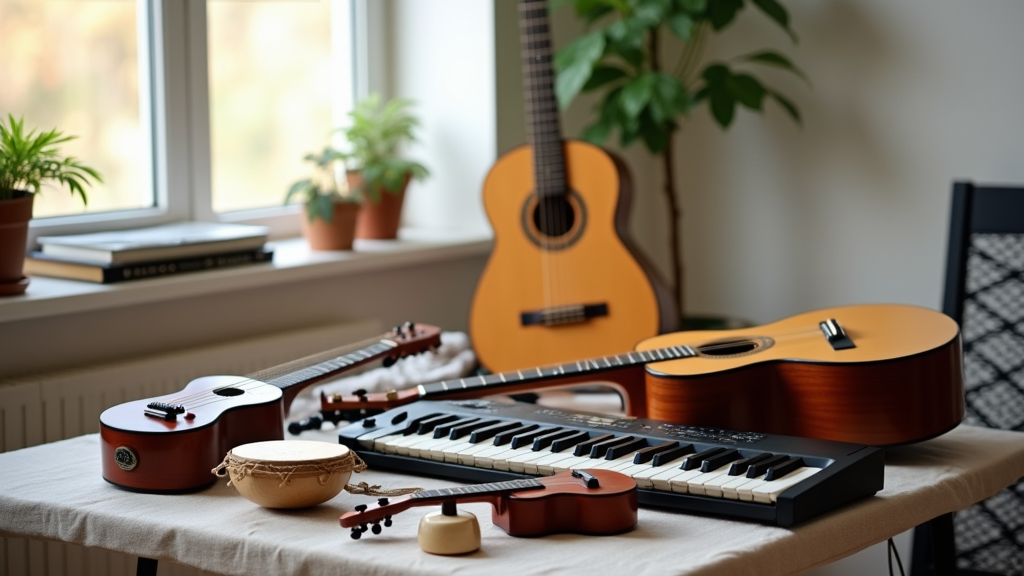Introduction
Music is a wonderful way to boost creativity and learning in a homeschool setting. When it comes to nurturing talent and making lessons more engaging, the right musical instrument can open up a world of creativity for your child. Whether your child is just starting out or already shows promise, choosing the right tool can transform a regular study session into an inspiring learning adventure.
The idea behind using musical instruments in homeschooling isn’t just about learning notes and scales. It is also about bringing together art, creativity, and academics into a unified experience. Music helps improve concentration, builds fine motor skills, and boosts confidence. In a flexible homeschool environment, you can set your pace and let your children experiment with sound in a relaxed and stress-free atmosphere. This article will review some of the best choices in musical instruments for homeschoolers and share practical tips to integrate them into your curriculum.
This post may contain affiliate links. When you click and purchase from any of our links, we may get a small commission at no extra cost to you. For more information, please see our affiliate disclosure.
Top Musical Instruments to Spark Creativity
Choosing an instrument for your homeschool curriculum can seem challenging with so many options available. The right musical instrument not only inspires fun but also supports different aspects of learning. Below are a few top recommendations that may really strike a chord with your child.
Acoustic Guitar: A Versatile Choice
The acoustic guitar is popular among both beginners and those with some experience. Available in various sizes for smaller hands, it helps introduce basic chords and melodies. Strumming can improve rhythm skills and can even be connected to other subjects like literature or creative writing. Many families enjoy playing guitar songs together as a fun, shared experience.
Keyboard and Digital Piano: Electronic Tunes for Homeschool
A keyboard or digital piano is a superb tool to familiarize children with music theory and composition. Its versatility makes it especially useful in a homeschool setting. With built-in lessons and options to experiment with different sounds, the instrument offers immediate auditory feedback and visual appeal. This makes it an engaging option even during short breaks between academic sessions.
Ukulele: Fun, Compact, and Easy to Learn
The ukulele is perfect for younger children due to its manageable size and cheerful sound. Its lightweight design means that even small hands can play it comfortably. Acting as an entry point into string instruments, the ukulele encourages motor skills and introduces basic musical notes without overwhelming beginners.
Percussion Instruments: Rhythm in Motion
Percussion instruments, whether a simple hand drum or a small drum set, inject energy into music lessons. Tapping along to a beat not only teaches rhythm but also fosters active participation. These instruments work well in both group sessions and individual practice, making them a lively addition to the learning schedule.
Recorder: Ideal for Beginners
The recorder is a classic introductory instrument. It is affordable and straightforward, making it ideal to learn basic melodies quickly. In addition to teaching breath control and clear articulation, the recorder serves as a stepping stone to more complex wind instruments.
Instrument Categories for Different Skill Levels
Not every student starts at the same level when it comes to music. The selection of musical instruments for a homeschool should match the varying needs and skills of your learners. Whether your child is just exploring sound or has already practiced for years, there is an instrument that fits perfectly into your educational plan.
Early Learners: Instruments That Ease In
For younger children or absolute beginners, simplicity is key. Instruments like the recorder and ukulele are excellent choices because they are easy to learn and come with a low price tag. They allow children to build initial confidence as they explore musical sounds without the pressure of complicated techniques. Their tactile nature also reinforces fine motor skills and hand-eye coordination.
Intermediate Players: Building on the Basics
Once your child is comfortable with the basics, instruments such as the acoustic guitar or digital piano provide an opportunity to expand their musical vocabulary. These tools encourage further exploration into chords, scales, and even composition. Using an instrument like a keyboard can gradually introduce broader music theory and arranging techniques, paving the way for deeper learning.
Advanced Music Skills: For the Committed Student
When a student is ready for more challenge, instruments such as the violin or flute open up new avenues of expression. The violin offers a more in-depth exploration into string instruments, demanding precision and discipline. Advanced instruments often integrate with subjects like math and physics because of the inherent science of acoustics. Such challenges keep the learning process both stimulating and rewarding.
Incorporating Music Education into Homeschooling
Integrating musical instruments into your homeschool curriculum can be both fun and educational. Scheduling regular music sessions not only builds discipline but also creates a creative outlet that complements academic studies. Even a brief session on the keyboard or a quick rhythm exercise on a drum pad can reenergize a long day of studies.
Cross-Disciplinary Learning
One effective method is linking music with other subjects. For instance, exploring rhythm can help understand fractions in math, while learning scales may illustrate patterns and sequences. You might use a digital piano to visually explain musical scales and then relate those patterns to natural sequences in science or art. This method creates a dynamic learning environment where multiple disciplines come together in exciting ways.
Creative Expression Projects
Set aside weekly time for creative music projects. Whether it’s improvising a tune on the acoustic guitar or composing a simple song on the keyboard, these projects offer both relaxation and excitement. Encouraging your child to write lyrics or create a melody can turn a standard music lesson into an engaging creative writing exercise.
Group Music Sessions
If you have multiple children or participate in a homeschool co-op, group music sessions can be extremely beneficial. Instruments like percussion sets present unique opportunities for collaboration. Playing together helps develop social skills and teamwork, and creates an environment where children feel comfortable sharing musical ideas and learning from one another.
Choosing the Best Instrument for Your Homeschool Journey
Selecting the right musical instrument depends on many factors, including your child’s interests, space availability, and budget. It is important to look for instruments that meet both short-term enjoyment and long-term educational goals. A thoughtful discussion with your child about the kind of music they enjoy can be a great starting point.
Begin by listening to various types of music together and observing which sounds capture their attention. If your child is drawn to rhythmic beats or soft melodies, let that guide your choice. Exploring online tutorials and videos can also be an eye-opening way to see what each instrument has to offer. Understanding the different sounds and techniques involved will help both you and your child make an informed decision.
Another key consideration is how well an instrument fits into your daily routine. Many digital instruments offer features such as adjustable difficulty levels and built-in practice modes that ease the learning curve. Scheduling regular practice sessions—even if just short bursts throughout the day—can help make music a consistent and joyful part of your homeschool routine.
Lastly, budget plays a practical role in the decision-making process. While the recorder and ukulele are very affordable, items like a digital piano or an advanced string instrument may require a larger investment. Starting small and gradually expanding your collection as interest grows is a sensible approach. Look into bundle deals or quality second-hand instruments to keep costs manageable while still providing excellent learning tools.
Listing the 10 Best Musical Instruments for Homeschooling Kids
- Acoustic Guitar: A versatile instrument that is excellent for learning chords and simple melodies. Its portability makes it a practical choice for practice in any setting.
- Digital Piano/Keyboard: Ideal for teaching music theory and composition. With built-in lessons and interactive features, it adds a modern twist to traditional learning.
- Ukulele: A compact, easy-to-master string instrument that introduces kids to the world of music through its light and cheerful sound.
- Percussion Set: Ranging from simple drum pads to full drum kits, percussion instruments promote rhythm and coordination in both solo and group settings.
- Recorder: A cost-effective option for beginners, the recorder builds fundamental skills like breath control and basic melody recognition.
- Violin: For learners ready for a greater challenge, the violin offers a more in-depth exploration into string instruments with its rich, expressive tone.
- Flute: A lightweight wind instrument that teaches precision in breath control while offering a gentle, soothing sound.
- Harmonica: Small and portable, the harmonica is excellent for spontaneous play and helps develop an ear for melodies without complex finger positions.
- Cajon: A box-shaped percussion instrument that introduces a modern twist to rhythm practice, ideal for interactive lessons.
- Digital Drum Pad: Perfect for tech-savvy homeschoolers, digital drum pads combine electronic beats with the fun of rhythm creation and can even interface with music production software.
Integrating Musical Instruments into Daily Learning
Making music a regular part of your homeschool schedule need not be complicated. Treat music as an important subject on its own. By setting aside dedicated time for rehearsal, lessons, and even free play, you offer your child an outlet for creative expression while reinforcing academic learning.
One simple method is to incorporate short music sessions into breaks from core subjects. For example, after a lengthy study period, a quick session on the keyboard or a rhythm exercise with a percussion set can refresh the mind and boost energy. These breaks can help improve concentration and maintain a balanced routine throughout the day.
Project-based learning is another great way to embed musical education into daily activities. Organize projects where your child composes a brief tune, researches famous composers, or even builds a simple instrument from everyday materials. Such activities not only spark creativity but also strengthen skills in research, problem-solving, and innovation.
Resources and Tools to Support Music Education at Home
Building a home music studio might seem challenging initially, but there are plenty of resources available to help you get started. From online tutorials to interactive apps, many tools provide step-by-step guides that simplify learning. Virtual lessons combined with physical practice can lend a balanced, engaging approach to music education.
Local music stores and online communities also offer valuable advice. They can be excellent sources for second-hand instruments or bundle deals that ease financial concerns. Being part of a network of homeschool families interested in music can lead to instrument swaps, group recitals, and shared learning experiences that benefit everyone.
Final Thoughts
Incorporating musical instruments into your homeschool can make learning more dynamic and enjoyable. Choosing tools such as the acoustic guitar, digital piano, or even a cajon can open up endless opportunities for creative expression and skill development. The process of learning music naturally builds discipline, improves concentration, and enhances overall academic performance.
Start small by selecting one or two instruments that align with your child’s interests. Over time, as confidence grows, consider introducing new instruments to keep the experience fresh and engaging. Encourage feedback from your child and experiment with different approaches until you find the perfect fit for your homeschooling style.
Music education is a long-lasting gift that connects both the heart and the mind. It often turns routine lessons into memorable experiences and inspires a lifelong passion for learning. Enjoy the process of finding the right instrument and watch as each note played brings not only fun but valuable skills to your child’s educational journey.
Additional Resources
- Article – Music Education for Kids: A Beginner’s Guide
- Article – Transform Learning: Incorporating Music Daily
- Tool – Interactive Music Theory Lessons
When you click and purchase from any of our links, we may get a small commission at no extra cost to you. For more information, please see our affiliate disclosure.


